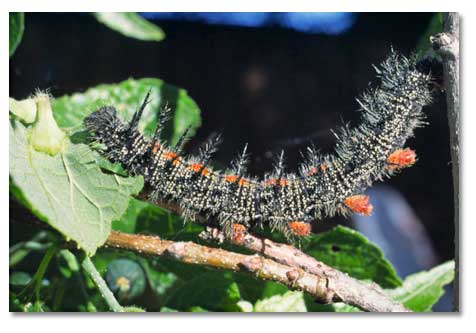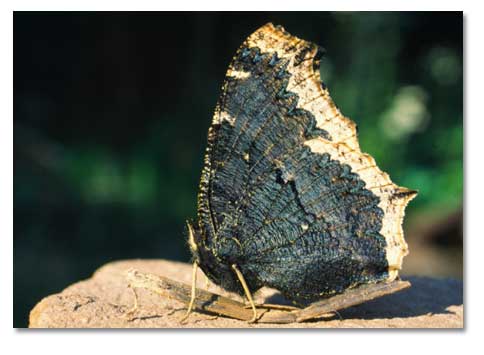The Day It Rained Mourning Cloaks
Mourning Cloaks Butterflys - Nymphalis antiopa
By Damian Fagan
The day it rained Mourning Cloak caterpillars, there wasn’t a cloud in the sky. My daughter, who was five at the time, and I were in our Moab backyard watching a Black-chinned Hummingbird sip nectar from a Golden Columbine. The hummingbird probed several other flowers in search of nectar as a southwesterly wind began to blow. Above us, the limbs of our neighbor’s hackberry tree began to swish back and forth. Soon afterwards, it started to rain caterpillars.
We saw one caterpillar land on the picnic table bench. It was about ¾ of an inch in length, coal black with white flecks and a row of reddish dorsal spots. It was covered with black, bottlebrush-like spines. During the next gust of wind, down came a few more caterpillars. One landed on my daughter’s plate as if inviting itself to lunch. After the next breeze blew through, the ground was littered with about 30 of these caterpillars.

Though my daughter didn’t want to pick up one of the “icky” caterpillars, I laid my open hand down on the ground in front of one. With no place else to go, the caterpillar climbed up my finger and into my hand.
“Aeewww…” my daughter exclaimed. I held the caterpillar up for her to see. Her eyes widened as she watched the caterpillar move across my hand. “Will it bite?” she asked.
I explained that these caterpillars ate plants, not people. We searched the tree limbs above us to confirm that these caterpillars had indeed come from that hackberry. The partially eaten leaves gave me an idea.
We collected a half dozen caterpillars and placed them in a terrarium. I added leaves and twigs from the hackberry. For the next several weeks, we cleaned out the butterfly poop, and added new leaves. The caterpillars continued to grow, and when they outgrew their skin, they molted into their next stage or instar.
The caterpillars were easy to identify as those of the Mourning Cloak butterfly (Nymphalis antiopa). Nymphalis means “pertaining to a fountain” and antiopa honors the wife of Lycus, King of Thebes. Unfortunately, the derivation of the scientific name is unclear. The butterfly’s common name comes from the adult’s dark wings which resembled the traditional woolen cloaks or coats worn back in the 1800s while someone was “in mourning.”

After about five weeks of captivity, we noticed that the caterpillars had entered a new phase of their lives. Though we had not counted their instars, many field guides suggest they go through four or five growth stages. The fattened caterpillars hung downwards on a twig, in the shape of the letter “J.” About a day later they had transformed into a grayish-tan, spiky chrysalis. The pupa is the resting stage, where the caterpillar metamorphoses into a butterfly.
We liked to joke that these were “lazy” caterpillars that just hung around all day. In fact, they hung around for about two weeks to complete this transition. Though we missed the butterflies emerging from their chrysalises, we were able to see the butterflies hanging upside down from the terrarium’s wire cover.
The undersides of the wings were dark brown with a lighter edge, helping to camouflage the butterfly when the wings are closed. The border of the wings had a series of irregular scallops and had short projections on both wings. When the adults opened their wings to bask in the sunlight, we could see that the uppersides were almost purple-black and had a brighter yellow to tannish border along the outer margins of the wings. Inside of these borders was a row of iridescent blue spots. With a three-inch wingspan, these were impressive butterflies.
With a magnifying glass we could see that the Mourning Cloak’s front pair of legs were small and hairy. Field guides describe them as “brushlike,” hence the family name Nymphalidae is referred to as the “brush-footed butterflies.” This family includes the royal members, for instance, the Monarchs, Viceroys and Queens, to name a few. Though six-legged, these Mourning Cloaks appeared to have only four legs.
The day we released the butterflies it was a warm summer day. The adults held tight to our fingers before they lifted off and glided away. Afterwards, we checked the tank and noticed that one chrysalis had not opened. We could see a tiny hole in the top of one empty chrysalis. Somehow another insect had preyed upon the developing chrysalis.
Throughout the rest of the July we would occasionally view a Mourning Cloak perched on the trunk of an elm tree in our yard. These adults would walk headfirst down the trunk to feeding spots where sap flowed from the tree. We didn’t put out rotting fruit like bananas, peaches or melons for these butterflies to feed on because these fruits seemed to attract a variety of bees and flies. We never saw the Mourning Cloaks drinking nectar from the flowers in the garden, but they are known to occasionally imbibe on floral nectar. Sometimes they were observed “puddling” where they landed on moist ground to obtain minerals from the wet soil.

At a certain point in the late summer, the butterflies were gone. Supposedly the adults will aestivate, or go into a temporary hibernation, then re-emerge to feed and store up energy for their overwintering period. These adults may emerge during winter if the temperatures are mild. Their dark wings heat up quickly, a necessary trait in colder climates. Otherwise, the butterflies hibernate beneath a flake of bark or loose siding and wait for warmer weather in spring.
These overwintering adults are the ones that breed, with males selecting perches in sunny afternoon locations where they wait for receptive females to appear. After their spring courtship, the females lay numerous eggs in loose groups on host plants that include willows, elms, hackberries, cottonwoods, aspens and birches. The eggs hatch in concert with the spring leaves, thus ensuring an ample food supply for the caterpillars. It was from one of these groups that my daughter and I collected our captive caterpillars and learned so much about these winged wonders.
Fast Facts
Mourning Cloak butterfly (Nymphalis antiopa).
Range: Mourning Cloaks occur throughout North America and into central Mexico, but are rare in the Gulf States and Florida. They also occur in Europe and Eurasia, where they are called the “Camberwell Beauty,” after the first recorded species, in Camberwell, London, in 1748.
Habitat: Found in woodlands, parks, riparian areas along streams and rivers, and residential areas.
Life Span: Adults may live 10 to 11 months, making them the longest-lived butterflies in the United States.
First Appearance: Late winter or early spring depending upon temperatures. These are often the first butterflies to emerge, sometimes before the snow has melted.
Wing Span: May be from 2 ¼ to 4 inches in length.
Montana State Butterfly: Designated in 2001.
![]()
Desert Animals & Wildlife
Desert Food Chain
Plants And Animals, How They Are Classified
Related DesertUSA Pages
- How to Turn Your Smartphone into a Survival Tool
- 26 Tips for Surviving in the Desert
- Death by GPS
- 7 Smartphone Apps to Improve Your Camping Experience
- Maps Parks and More
- Desert Survival Skills
- How to Keep Ice Cold in the Desert
- Desert Rocks, Minerals & Geology Index
- Preparing an Emergency Survival Kit
Share this page on Facebook:
The Desert Environment
The North American Deserts
Desert Geological Terms



